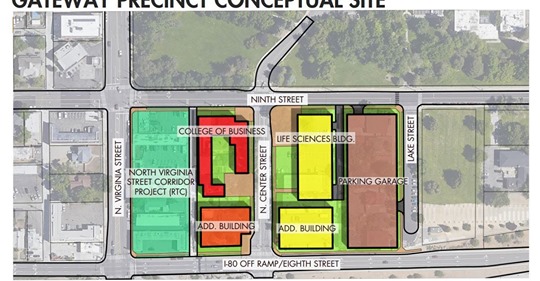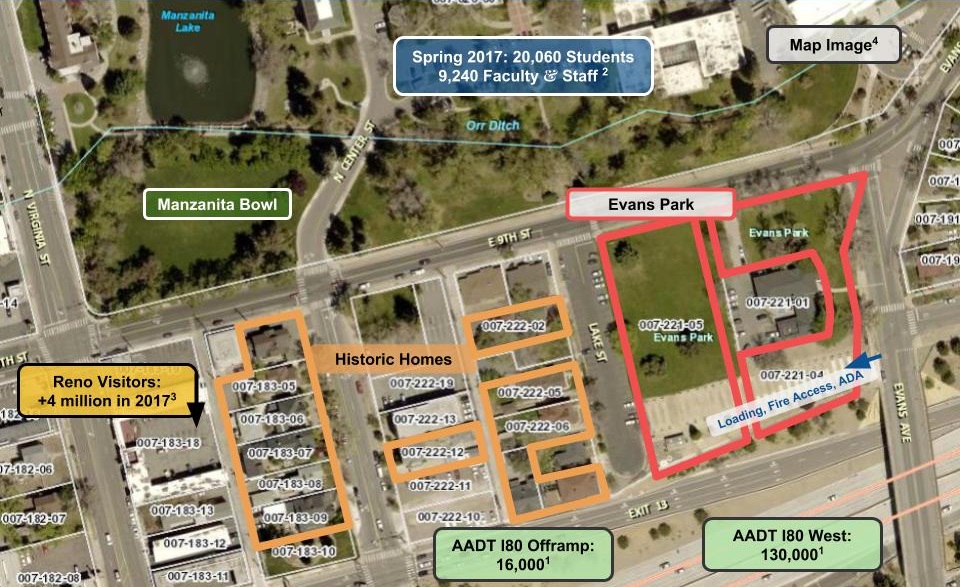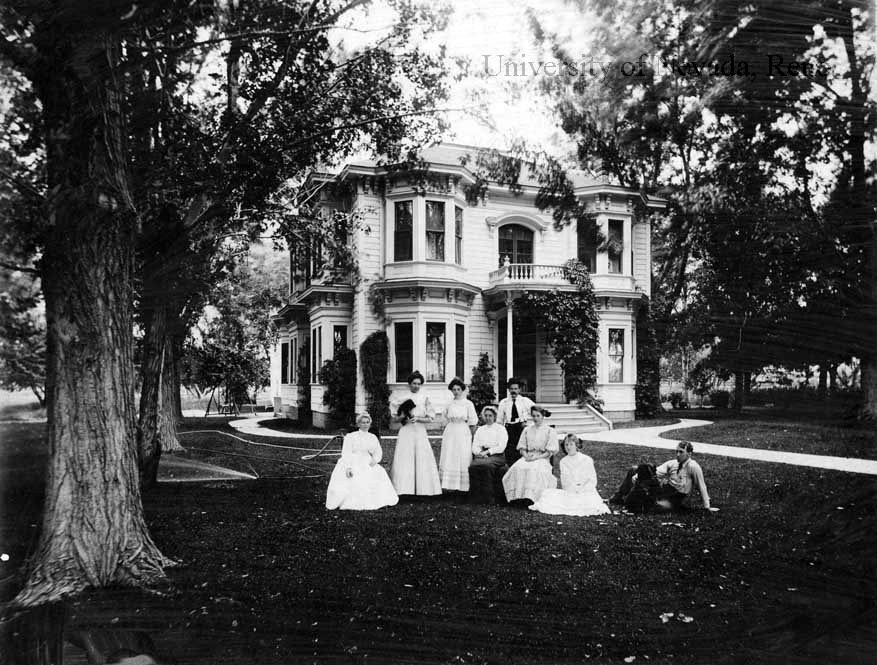

The University did not choose our proposal but the coalition has continued to work to preserve these homes. Please follow RenoHistorical.org to learn how you can continue to support Reno's history.
As we await word any day that the University of Nevada, Reno will begin to raze the historic houses of the "Gateway" just south of campus for future construction (and to end the controversy, in the words of UNR President Marc Johnson), I just want everyone to take a good hard look at the site plan accompanying this news story. Please note how UNR persists in indicating that the RTC needs an entire half block for their transit project, when the RTC's own public plans show that they will require only a fraction of that space, bordering Virginia Street, for what is essentially a bus pullout (see comments for a comparison diagram). The RTC does have to purchase the whole parcels along Virginia (that's how property purchases work), which extend back to the alley between Virginia and Center Streets, but what happens to all of the land they don't need, just to the east of their project, will be determined later.

The historic sections of all of the 1890s houses currently on the west side of Center Street could remain in place while shifting the footprints of the future College of Business building and its southern counterpart slightly further to the west, making them even more prominent when entering campus from Virginia Street. We call that a win-win. And yet President Johnson absolutely refused to consider doing so, even though that entire row of charming, character-rich houses could have been filled with student-oriented businesses, eateries, and university services, and their front lawns filled with outdoor tables and chairs and activities. Not only would everything that UNR wants still have fit in the Gateway, but such a plan would have beautifully blended the past, present, and future, and represented a meeting of university and community--not only figuratively but physically. And students would have loved it.
President Johnson promised in front of Reno City Council in 2016 to preserve these historic houses, and when he gives the signal to demolish them, I just want it to be very clear to everyone that he made a deliberate choice not to incorporate them into his new Gateway vision, and that his administration worked on their own, without consulting any experts in history or historic preservation, first to try to wedge some of them into a narrow site perched on the edge of an embankment high above Interstate 80, then to formulate a hasty and uninformed Request for Proposals (a baffling and completely inappropriate process) to solicit relocation proposals for them in just six weeks, then to give them to a group that had a completely unrealistic proposal to move them 100 miles north into the desert, and when that fell through, to do absolutely nothing more (since LAST OCTOBER--eight months ago) to advertise the availability of these houses anywhere--not on the UNR's real estate page, not among Realtors, not to their alumni or donors, not to staff or faculty, not in any public notices or advertisements--nothing.
And now they say it's too late, even though construction of the Business Building is AT LEAST two years away. These are all deliberate choices, and you can read my blog for the entire disappointing blow-by-blow as well as specifics about the RTC's stated needs and the preservation community's proposed solution. But at the end of the day, let's be clear that the almost assured loss of the majority of these houses--including the iconic Atcheson House--called the most beautiful residence in Reno upon its completion in 1895--is due not to a failure of the community to find the resources to move them, but to a failure of imagination that has blown a one-of-a-kind opportunity to demonstrate the university's commitment to the community, to collaboration, to professional expertise, to a beauty-rich environment, to pedestrian-scale student-centered amenities, and to the notion that we are all the stewards of our community's heritage, a responsibility some public officials take more seriously than others.
- Alicia Barber, aliciambarber.com

Evans Historic Park is a concept that transforms the current Evans Park into a dynamic community-oriented space. By relocating eleven of the historical Gateway buildings around the perimeter of the park, our plan strives to create a $2million endowment and perpetual care fund for City parks and to establish the city staff position of historic preservation planner. Evans Historic Park is a project that benefits the community by creating a beautiful setting where small businesses can offer services and amenities within walking distance to the UNR campus and downtown.
A historic preservation professional will oversee many aspects of the project to ensure that the integrity of these eleven structures, built between 1895-1920, are retained and that owners receive education and support in renovating and maintaining them. The properties will be listed on the City's Historic Register, and a property owners' association will be created to establish standards for operation and maintenance. A system of interpretive signage will provide an educational element to the park, celebrating Reno’s history and the contributions of the Evans family to this site. In the year of Reno’s Sesquicentennial, we cannot think of a more meaningful project.
City Council voted to continue to work with Truckee Meadows Heritage Trust to move the plan forward. We submitted the proposal to the University of Nevada.
City of Reno presentation, public comment, and City Council discussion on Evans Historic Park. (7:07 to 8:31)
After a lively and multifaceted discussion, Reno City Council expressed a desire to delve more deeply into the proposal and unanimously approved a motion.
Evans Historic Park provides an opportunity for many community partners and individuals to be involved. Whether you would like to join our investment team, own one of these beautiful structures, run a small business, or volunteer to help create the committees that will see this project through to completion, there is a place for you. We look forward to hearing from you!

Evans Park used to serve residential neighborhoods within 1/4 mile.
♦ Proposal is subject to revision & approval.
Evans Historic Park is a concept that provides an opportunity for many community partners and individuals to be involved. In order for this concept to become a reality, we need a show of support from members of the public, we need the approval of the City and we need the University to award us the RFP which is due on June 7. There will likely be competing applicants, so public support for this idea is important.


Photograph of Evans House at the corner of Evans Avenue and 9th Street, ca. 1905. Mrs. J. N. Evans, Bess Evans, Italia Flave (?), Ella Kalfus Evans, Benjamin Metcalf, Rowena Evans, Guysme (?) Davis, Ben Allen Evans. Chuckle, dog. Coalie, dog. Special Collections Department, University of Nevada, Reno Libraries
In Reno’s early days, many Easterners were coming west to seek their fortunes and a life of adventure. Among these new residents were the Evans brothers from Defiance, Ohio. The Evans family produced 13 children, at least six of whom came west and eventually made their home in the Reno area. Brothers Alvaro and John Newton “Newt” Evans owned land from 5th Street north to what is today McCarran Blvd. Newt sold the state land for the University of Nevada when it was moved from Elko in 1885.
In 1889, Alvaro sold a plot of land at the foot of the university bounded by Virginia and N. Center Streets between 8th and 9th Streets to financier A. G. Fletcher, who subdivided the land into 14 lots. Fletcher began selling his lots in the last decade of the 19th century and shortly thereafter, homes along the west side of N. Center St. began springing up. Center Street, at various times called University Avenue, was part of a larger historical neighborhood that was divided by the construction of Interstate 80 in the 1960s and 1970s.
Continue reading on RenoHistorical.org